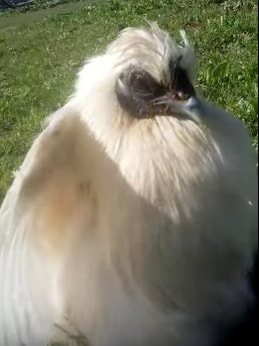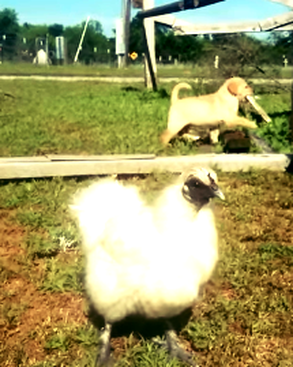If your chickens have been getting sick, looking droopy, pale or has other symptoms listed in our chart, a vitamin deficiency may be the culprit. See symptoms and causes of poultry vitamin deficiencies and dietary adjustments you can make that could fix the problem here.
Symptoms of Vitamin Deficiencies in Poultry
 Lady Silkie a hen I rescued who made a full recovery from a vitamin deficiency. (c) 2017. CHOE.
Lady Silkie a hen I rescued who made a full recovery from a vitamin deficiency. (c) 2017. CHOE.
A vitamin deficiency can cause your chickens and other poultry to appear listless, have pale combs, wattles, and shanks, have pustules in the mouth and nasal passages, watery discharge from nostrils and eyes, emaciation, poor growth rate, lay less eggs, leg weakness, soft beaks and claws, soft shelled eggs, lower hatch rates, and other symptoms listed in the Poultry Vitamin Deficiency Chart below. Most commercial chicken feed has all the vitamins your chickens need but some do not or don't have enough. If your bird is showing any of these symptoms you should give them a vitamin supplement and if that fixes the problem then you may need to switch feed. See more causes of vitamin deficiencies below the chart. If you are making your own chicken feed you need to be sure to include foods that have all of the vitamins they need.
The following are six vitamins that are essential to your birds health. See more information below the chart.
The following are six vitamins that are essential to your birds health. See more information below the chart.
Poultry Vitamin Deficiency Chart
Name of Vitamin |
How Vitamin Can Be Obtained |
Benefits of The Vitamin |
Symptoms of Vitamin Deficiency |
Vitamin A |
Green leaf material like: Raw collard greens, Mustard greens, Spinach, Dandelion greens, and Kale. |
Aids: Vision Growth Reproduction Maintenance of mucous membranes Growth of cartilage in bones |
Young birds: Listlessness ruffled plumage, Pale combs, wattles, beaks and shanks. Pustules in nasal passage, mouth; Lameness Adult birds: Decreased egg production. Less hatchable eggs. Watery discharge from nostrils and eyes. Pustules in nasal passage and mouth. Emaciation and weakness. Learn More... |
Vitamin D |
Synthesized by the action of light on the skin. Fish liver oils Fatty fish Tuna Mackerel Salmon |
Necessary for absorption of calcium in the diet. General calcium metabolism and maintenance of bone structure. |
Young birds: Rickets (leg weakness). Soft beaks and claws. Poor growth. Adult birds: Decreased production and hatchability of eggs. Soft-shelled eggs. Fragile bones. |
Vitamin E |
Cereals Vegetable oils Palm oil Wheatgerm Sunflower seeds Sweet Potatoes |
Aids in a wide range of biological functions |
Young birds: Poor coordination, unsteady gait “crazy chick disease” (rapid contraction and relaxation of head and leg muscles). Adult birds: Reduced hatchability of eggs due to degeneration of testes in males. |
Vitamin K |
Green leaf material like: Raw collard greens, Mustard greens, Spinach, Dandelion greens, and Kale. |
Needed for healthy blood |
Young and adult birds: Increased bruising and bleeding. |
Vitamin B1 (Thiamine) |
Cereal grains Soya bean meal Yeast Peas Beef liver Legumes Cheese |
Needed for a wide range of biological functions |
Young and adult birds - Decreased appetite and weight loss. Leg weakness and muscle paralysis. “Stargazing” (head retracted and legs thrust forward). |
Vitamin B2 (Riboflavin) |
Green plants Lettuce Yeast Eggs Milk |
Essential for growth and tissue repair. |
Young birds - Poor growth. Toes curled inwards, clubbed down. Adult birds - Decreased hatchability of eggs. |
Reasons Why Chickens Get Vitamin Deficiencies
 Lady Silkie made a full recovery from a vitamin deficiency. (c). 2017. CHOE
Lady Silkie made a full recovery from a vitamin deficiency. (c). 2017. CHOE
Some of the main reasons chickens suffer from vitamin deficiencies are:
Low quality chicken feed
Improper storage of feed-"Vitamins are required only in small amounts but are essential for growth and production. All good quality commercial feeds will contain the required amount of vitamins and this will be stated on the label. However, vitamins can be destroyed by the action of heat and water, and may break down during prolonged storage. Feed should, therefore, be stored in a cool, dry shed and bought in small amounts to avoid long storage" (Northern Territory Government, 2018).
Homemade feed that does not contain the proper ingredients
Too many treats
Lack of free range time out hunting insects and foraging green leaf materials
Not enough protein
"A well-balanced diet is essential for maximum growth, production and health of a poultry flock. The components of a diet are energy, protein, vitamins and minerals. They must be present in the correct proportions. Nutritional problems occur when the overall dietary amount is inadequate, or when the components of the diet are not balanced. Feed is used by the bird first for maintenance (normal body functions) and second for growth and/or production (i.e. meat or eggs). An inadequate diet will lead to a decline in growth of young birds or a drop in egg production in laying hens. Dietary requirements vary with age, sex and laying status. For instance, a six-week-old chick requires 1% calcium and 20% protein whereas a layer requires 3.6% calcium and 16% protein. The protein component in a diet can come from an animal source, such as meat meal or fish meal, or a plant source, such as soybean meal. Dietary protein is used by the bird to build its own protein (muscle) and/or egg protein. A protein-deficient diet will lead to poor growth and low egg production"(Northern Territory Government, 2018).
Low quality chicken feed
Improper storage of feed-"Vitamins are required only in small amounts but are essential for growth and production. All good quality commercial feeds will contain the required amount of vitamins and this will be stated on the label. However, vitamins can be destroyed by the action of heat and water, and may break down during prolonged storage. Feed should, therefore, be stored in a cool, dry shed and bought in small amounts to avoid long storage" (Northern Territory Government, 2018).
Homemade feed that does not contain the proper ingredients
Too many treats
Lack of free range time out hunting insects and foraging green leaf materials
Not enough protein
"A well-balanced diet is essential for maximum growth, production and health of a poultry flock. The components of a diet are energy, protein, vitamins and minerals. They must be present in the correct proportions. Nutritional problems occur when the overall dietary amount is inadequate, or when the components of the diet are not balanced. Feed is used by the bird first for maintenance (normal body functions) and second for growth and/or production (i.e. meat or eggs). An inadequate diet will lead to a decline in growth of young birds or a drop in egg production in laying hens. Dietary requirements vary with age, sex and laying status. For instance, a six-week-old chick requires 1% calcium and 20% protein whereas a layer requires 3.6% calcium and 16% protein. The protein component in a diet can come from an animal source, such as meat meal or fish meal, or a plant source, such as soybean meal. Dietary protein is used by the bird to build its own protein (muscle) and/or egg protein. A protein-deficient diet will lead to poor growth and low egg production"(Northern Territory Government, 2018).
1. (2018). Nt.gov.au. Retrieved 3 April 2018, from https://nt.gov.au/__data/assets/pdf_file/0016/233062/non-infectious-diseases.pdf
2. Laos chicken. (2018). Flickr. Retrieved 17 May 2018, from https://www.flickr.com/photos/7155605@N03/25337622787
2. Laos chicken. (2018). Flickr. Retrieved 17 May 2018, from https://www.flickr.com/photos/7155605@N03/25337622787

